Analysis of Unilever's Supply Chain Management (MGT6801 Report)
VerifiedAdded on 2022/11/30
|10
|3131
|121
Report
AI Summary
This report provides a comprehensive analysis of Unilever's supply chain management, examining key aspects such as supply chain relationships, the integration of information systems, procurement and outsourcing strategies, and sustainability initiatives. The report delves into the types of supply chain relationships employed by Unilever, exploring how these relationships are integrated and supported by IT systems to enhance collaboration and efficiency. It critically evaluates ways to improve these relationships and analyzes the impact of logistics and supply chain management on Unilever's return on investment (ROI). Furthermore, the report investigates Unilever's procurement strategies, focusing on risk mitigation and cost reduction, as well as its outsourcing practices in terms of competence and competitiveness. Finally, the analysis assesses Unilever's efforts to improve supply chain sustainability, including its use of reverse logistics. The report draws on relevant concepts and models to provide a detailed and insightful overview of Unilever's supply chain management practices.
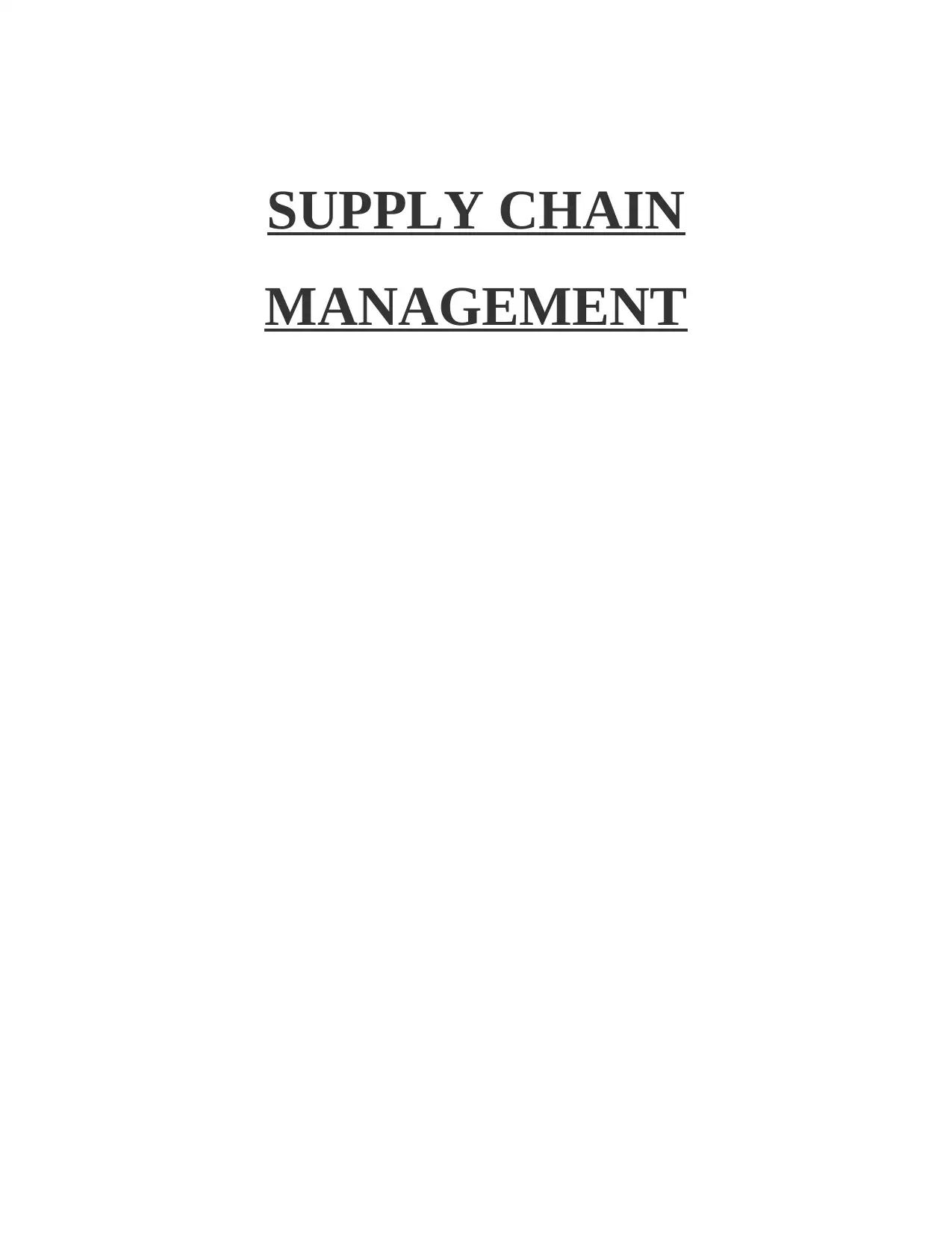
SUPPLY CHAIN
MANAGEMENT
MANAGEMENT
Paraphrase This Document
Need a fresh take? Get an instant paraphrase of this document with our AI Paraphraser
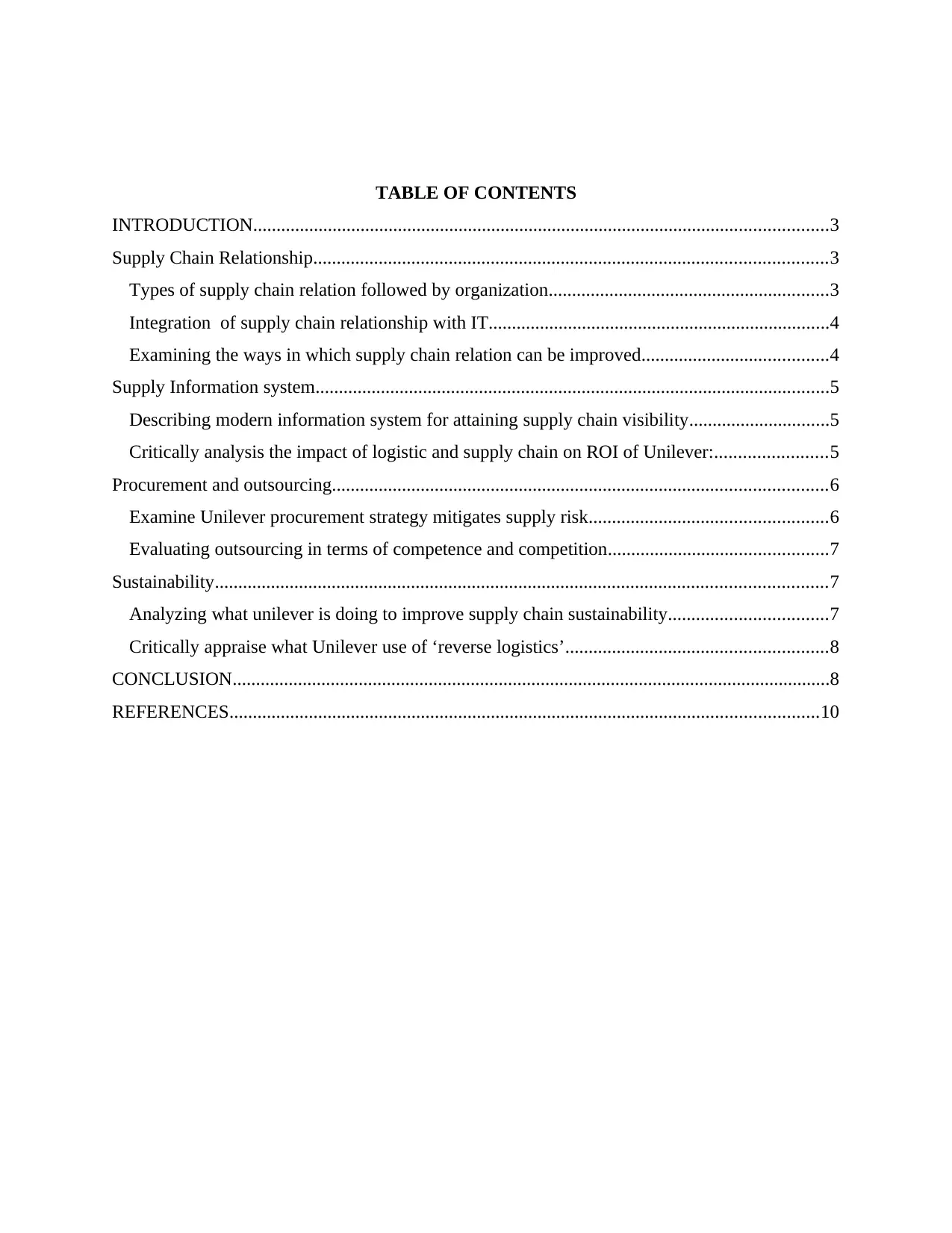
TABLE OF CONTENTS
INTRODUCTION...........................................................................................................................3
Supply Chain Relationship..............................................................................................................3
Types of supply chain relation followed by organization............................................................3
Integration of supply chain relationship with IT.........................................................................4
Examining the ways in which supply chain relation can be improved........................................4
Supply Information system..............................................................................................................5
Describing modern information system for attaining supply chain visibility..............................5
Critically analysis the impact of logistic and supply chain on ROI of Unilever:........................5
Procurement and outsourcing..........................................................................................................6
Examine Unilever procurement strategy mitigates supply risk...................................................6
Evaluating outsourcing in terms of competence and competition...............................................7
Sustainability...................................................................................................................................7
Analyzing what unilever is doing to improve supply chain sustainability..................................7
Critically appraise what Unilever use of ‘reverse logistics’........................................................8
CONCLUSION................................................................................................................................8
REFERENCES..............................................................................................................................10
INTRODUCTION...........................................................................................................................3
Supply Chain Relationship..............................................................................................................3
Types of supply chain relation followed by organization............................................................3
Integration of supply chain relationship with IT.........................................................................4
Examining the ways in which supply chain relation can be improved........................................4
Supply Information system..............................................................................................................5
Describing modern information system for attaining supply chain visibility..............................5
Critically analysis the impact of logistic and supply chain on ROI of Unilever:........................5
Procurement and outsourcing..........................................................................................................6
Examine Unilever procurement strategy mitigates supply risk...................................................6
Evaluating outsourcing in terms of competence and competition...............................................7
Sustainability...................................................................................................................................7
Analyzing what unilever is doing to improve supply chain sustainability..................................7
Critically appraise what Unilever use of ‘reverse logistics’........................................................8
CONCLUSION................................................................................................................................8
REFERENCES..............................................................................................................................10
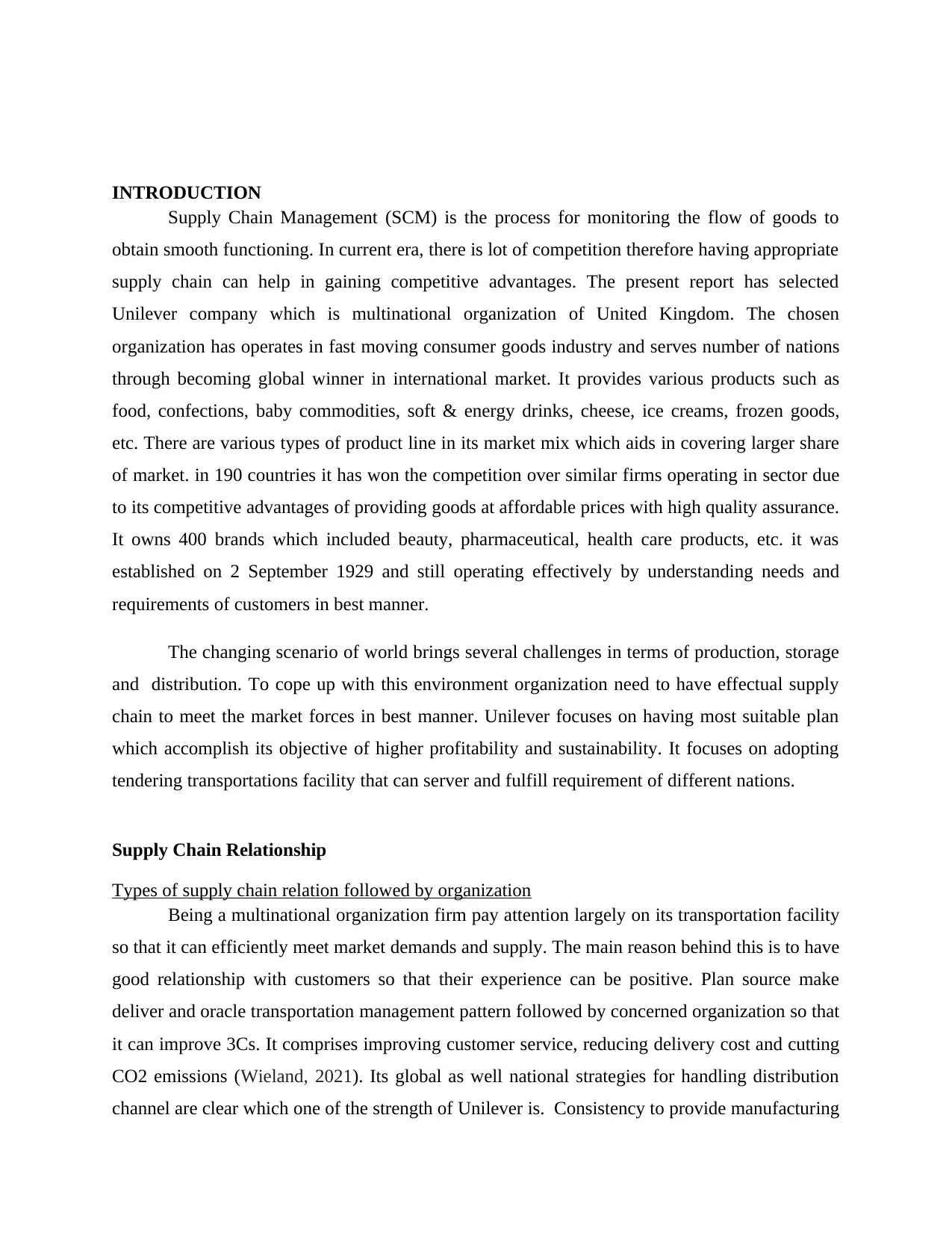
INTRODUCTION
Supply Chain Management (SCM) is the process for monitoring the flow of goods to
obtain smooth functioning. In current era, there is lot of competition therefore having appropriate
supply chain can help in gaining competitive advantages. The present report has selected
Unilever company which is multinational organization of United Kingdom. The chosen
organization has operates in fast moving consumer goods industry and serves number of nations
through becoming global winner in international market. It provides various products such as
food, confections, baby commodities, soft & energy drinks, cheese, ice creams, frozen goods,
etc. There are various types of product line in its market mix which aids in covering larger share
of market. in 190 countries it has won the competition over similar firms operating in sector due
to its competitive advantages of providing goods at affordable prices with high quality assurance.
It owns 400 brands which included beauty, pharmaceutical, health care products, etc. it was
established on 2 September 1929 and still operating effectively by understanding needs and
requirements of customers in best manner.
The changing scenario of world brings several challenges in terms of production, storage
and distribution. To cope up with this environment organization need to have effectual supply
chain to meet the market forces in best manner. Unilever focuses on having most suitable plan
which accomplish its objective of higher profitability and sustainability. It focuses on adopting
tendering transportations facility that can server and fulfill requirement of different nations.
Supply Chain Relationship
Types of supply chain relation followed by organization
Being a multinational organization firm pay attention largely on its transportation facility
so that it can efficiently meet market demands and supply. The main reason behind this is to have
good relationship with customers so that their experience can be positive. Plan source make
deliver and oracle transportation management pattern followed by concerned organization so that
it can improve 3Cs. It comprises improving customer service, reducing delivery cost and cutting
CO2 emissions (Wieland, 2021). Its global as well national strategies for handling distribution
channel are clear which one of the strength of Unilever is. Consistency to provide manufacturing
Supply Chain Management (SCM) is the process for monitoring the flow of goods to
obtain smooth functioning. In current era, there is lot of competition therefore having appropriate
supply chain can help in gaining competitive advantages. The present report has selected
Unilever company which is multinational organization of United Kingdom. The chosen
organization has operates in fast moving consumer goods industry and serves number of nations
through becoming global winner in international market. It provides various products such as
food, confections, baby commodities, soft & energy drinks, cheese, ice creams, frozen goods,
etc. There are various types of product line in its market mix which aids in covering larger share
of market. in 190 countries it has won the competition over similar firms operating in sector due
to its competitive advantages of providing goods at affordable prices with high quality assurance.
It owns 400 brands which included beauty, pharmaceutical, health care products, etc. it was
established on 2 September 1929 and still operating effectively by understanding needs and
requirements of customers in best manner.
The changing scenario of world brings several challenges in terms of production, storage
and distribution. To cope up with this environment organization need to have effectual supply
chain to meet the market forces in best manner. Unilever focuses on having most suitable plan
which accomplish its objective of higher profitability and sustainability. It focuses on adopting
tendering transportations facility that can server and fulfill requirement of different nations.
Supply Chain Relationship
Types of supply chain relation followed by organization
Being a multinational organization firm pay attention largely on its transportation facility
so that it can efficiently meet market demands and supply. The main reason behind this is to have
good relationship with customers so that their experience can be positive. Plan source make
deliver and oracle transportation management pattern followed by concerned organization so that
it can improve 3Cs. It comprises improving customer service, reducing delivery cost and cutting
CO2 emissions (Wieland, 2021). Its global as well national strategies for handling distribution
channel are clear which one of the strength of Unilever is. Consistency to provide manufacturing
⊘ This is a preview!⊘
Do you want full access?
Subscribe today to unlock all pages.

Trusted by 1+ million students worldwide
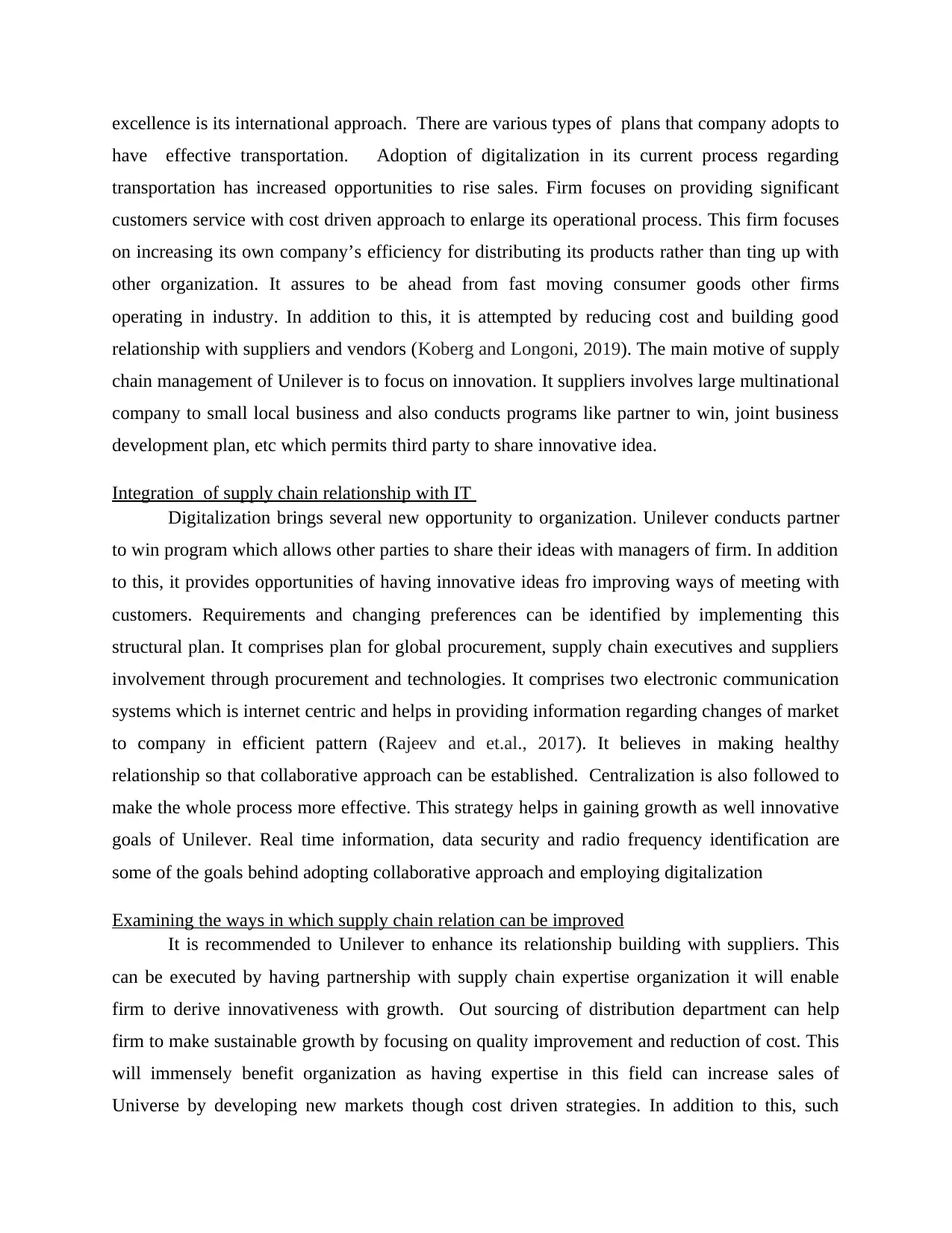
excellence is its international approach. There are various types of plans that company adopts to
have effective transportation. Adoption of digitalization in its current process regarding
transportation has increased opportunities to rise sales. Firm focuses on providing significant
customers service with cost driven approach to enlarge its operational process. This firm focuses
on increasing its own company’s efficiency for distributing its products rather than ting up with
other organization. It assures to be ahead from fast moving consumer goods other firms
operating in industry. In addition to this, it is attempted by reducing cost and building good
relationship with suppliers and vendors (Koberg and Longoni, 2019). The main motive of supply
chain management of Unilever is to focus on innovation. It suppliers involves large multinational
company to small local business and also conducts programs like partner to win, joint business
development plan, etc which permits third party to share innovative idea.
Integration of supply chain relationship with IT
Digitalization brings several new opportunity to organization. Unilever conducts partner
to win program which allows other parties to share their ideas with managers of firm. In addition
to this, it provides opportunities of having innovative ideas fro improving ways of meeting with
customers. Requirements and changing preferences can be identified by implementing this
structural plan. It comprises plan for global procurement, supply chain executives and suppliers
involvement through procurement and technologies. It comprises two electronic communication
systems which is internet centric and helps in providing information regarding changes of market
to company in efficient pattern (Rajeev and et.al., 2017). It believes in making healthy
relationship so that collaborative approach can be established. Centralization is also followed to
make the whole process more effective. This strategy helps in gaining growth as well innovative
goals of Unilever. Real time information, data security and radio frequency identification are
some of the goals behind adopting collaborative approach and employing digitalization
Examining the ways in which supply chain relation can be improved
It is recommended to Unilever to enhance its relationship building with suppliers. This
can be executed by having partnership with supply chain expertise organization it will enable
firm to derive innovativeness with growth. Out sourcing of distribution department can help
firm to make sustainable growth by focusing on quality improvement and reduction of cost. This
will immensely benefit organization as having expertise in this field can increase sales of
Universe by developing new markets though cost driven strategies. In addition to this, such
have effective transportation. Adoption of digitalization in its current process regarding
transportation has increased opportunities to rise sales. Firm focuses on providing significant
customers service with cost driven approach to enlarge its operational process. This firm focuses
on increasing its own company’s efficiency for distributing its products rather than ting up with
other organization. It assures to be ahead from fast moving consumer goods other firms
operating in industry. In addition to this, it is attempted by reducing cost and building good
relationship with suppliers and vendors (Koberg and Longoni, 2019). The main motive of supply
chain management of Unilever is to focus on innovation. It suppliers involves large multinational
company to small local business and also conducts programs like partner to win, joint business
development plan, etc which permits third party to share innovative idea.
Integration of supply chain relationship with IT
Digitalization brings several new opportunity to organization. Unilever conducts partner
to win program which allows other parties to share their ideas with managers of firm. In addition
to this, it provides opportunities of having innovative ideas fro improving ways of meeting with
customers. Requirements and changing preferences can be identified by implementing this
structural plan. It comprises plan for global procurement, supply chain executives and suppliers
involvement through procurement and technologies. It comprises two electronic communication
systems which is internet centric and helps in providing information regarding changes of market
to company in efficient pattern (Rajeev and et.al., 2017). It believes in making healthy
relationship so that collaborative approach can be established. Centralization is also followed to
make the whole process more effective. This strategy helps in gaining growth as well innovative
goals of Unilever. Real time information, data security and radio frequency identification are
some of the goals behind adopting collaborative approach and employing digitalization
Examining the ways in which supply chain relation can be improved
It is recommended to Unilever to enhance its relationship building with suppliers. This
can be executed by having partnership with supply chain expertise organization it will enable
firm to derive innovativeness with growth. Out sourcing of distribution department can help
firm to make sustainable growth by focusing on quality improvement and reduction of cost. This
will immensely benefit organization as having expertise in this field can increase sales of
Universe by developing new markets though cost driven strategies. In addition to this, such
Paraphrase This Document
Need a fresh take? Get an instant paraphrase of this document with our AI Paraphraser
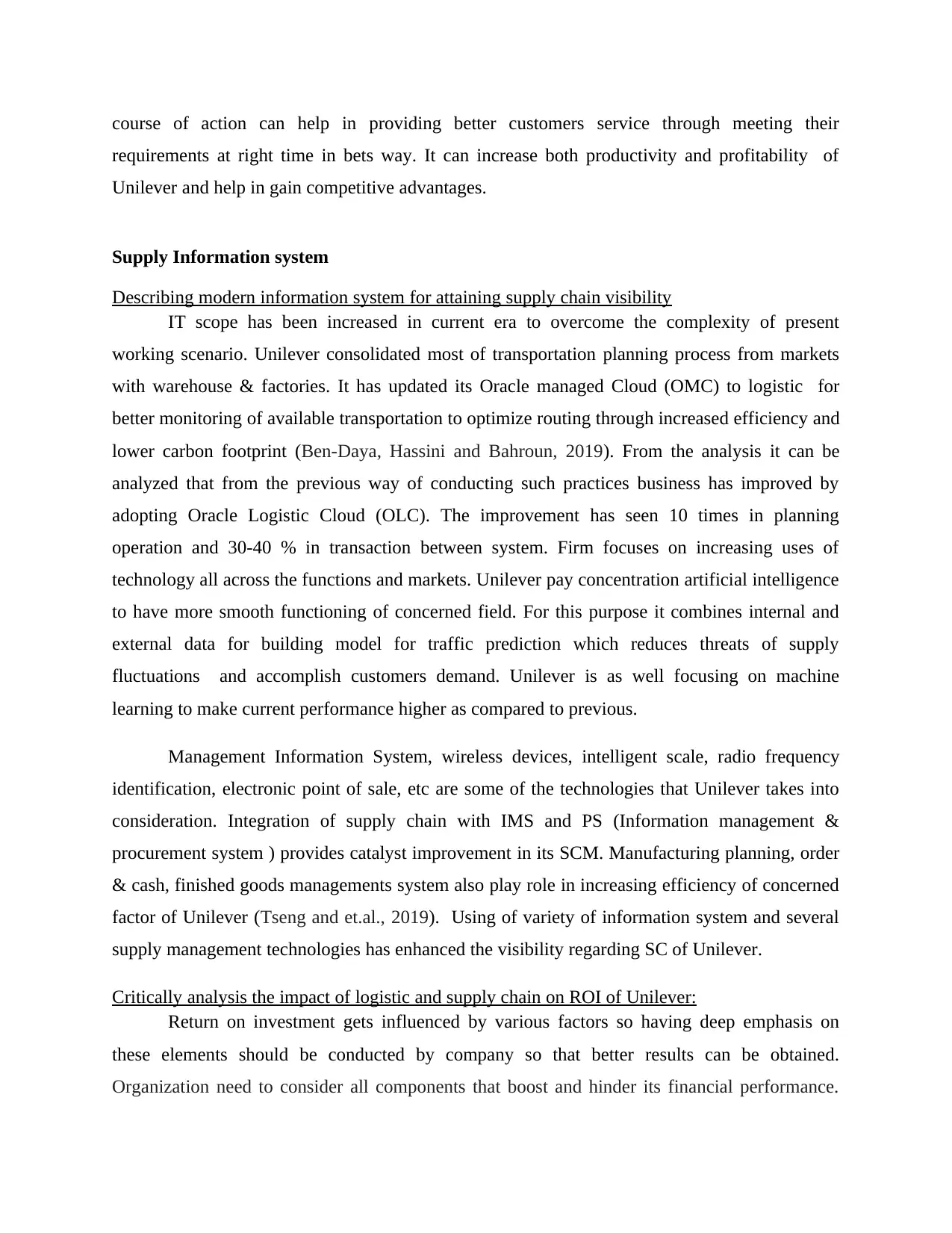
course of action can help in providing better customers service through meeting their
requirements at right time in bets way. It can increase both productivity and profitability of
Unilever and help in gain competitive advantages.
Supply Information system
Describing modern information system for attaining supply chain visibility
IT scope has been increased in current era to overcome the complexity of present
working scenario. Unilever consolidated most of transportation planning process from markets
with warehouse & factories. It has updated its Oracle managed Cloud (OMC) to logistic for
better monitoring of available transportation to optimize routing through increased efficiency and
lower carbon footprint (Ben-Daya, Hassini and Bahroun, 2019). From the analysis it can be
analyzed that from the previous way of conducting such practices business has improved by
adopting Oracle Logistic Cloud (OLC). The improvement has seen 10 times in planning
operation and 30-40 % in transaction between system. Firm focuses on increasing uses of
technology all across the functions and markets. Unilever pay concentration artificial intelligence
to have more smooth functioning of concerned field. For this purpose it combines internal and
external data for building model for traffic prediction which reduces threats of supply
fluctuations and accomplish customers demand. Unilever is as well focusing on machine
learning to make current performance higher as compared to previous.
Management Information System, wireless devices, intelligent scale, radio frequency
identification, electronic point of sale, etc are some of the technologies that Unilever takes into
consideration. Integration of supply chain with IMS and PS (Information management &
procurement system ) provides catalyst improvement in its SCM. Manufacturing planning, order
& cash, finished goods managements system also play role in increasing efficiency of concerned
factor of Unilever (Tseng and et.al., 2019). Using of variety of information system and several
supply management technologies has enhanced the visibility regarding SC of Unilever.
Critically analysis the impact of logistic and supply chain on ROI of Unilever:
Return on investment gets influenced by various factors so having deep emphasis on
these elements should be conducted by company so that better results can be obtained.
Organization need to consider all components that boost and hinder its financial performance.
requirements at right time in bets way. It can increase both productivity and profitability of
Unilever and help in gain competitive advantages.
Supply Information system
Describing modern information system for attaining supply chain visibility
IT scope has been increased in current era to overcome the complexity of present
working scenario. Unilever consolidated most of transportation planning process from markets
with warehouse & factories. It has updated its Oracle managed Cloud (OMC) to logistic for
better monitoring of available transportation to optimize routing through increased efficiency and
lower carbon footprint (Ben-Daya, Hassini and Bahroun, 2019). From the analysis it can be
analyzed that from the previous way of conducting such practices business has improved by
adopting Oracle Logistic Cloud (OLC). The improvement has seen 10 times in planning
operation and 30-40 % in transaction between system. Firm focuses on increasing uses of
technology all across the functions and markets. Unilever pay concentration artificial intelligence
to have more smooth functioning of concerned field. For this purpose it combines internal and
external data for building model for traffic prediction which reduces threats of supply
fluctuations and accomplish customers demand. Unilever is as well focusing on machine
learning to make current performance higher as compared to previous.
Management Information System, wireless devices, intelligent scale, radio frequency
identification, electronic point of sale, etc are some of the technologies that Unilever takes into
consideration. Integration of supply chain with IMS and PS (Information management &
procurement system ) provides catalyst improvement in its SCM. Manufacturing planning, order
& cash, finished goods managements system also play role in increasing efficiency of concerned
factor of Unilever (Tseng and et.al., 2019). Using of variety of information system and several
supply management technologies has enhanced the visibility regarding SC of Unilever.
Critically analysis the impact of logistic and supply chain on ROI of Unilever:
Return on investment gets influenced by various factors so having deep emphasis on
these elements should be conducted by company so that better results can be obtained.
Organization need to consider all components that boost and hinder its financial performance.
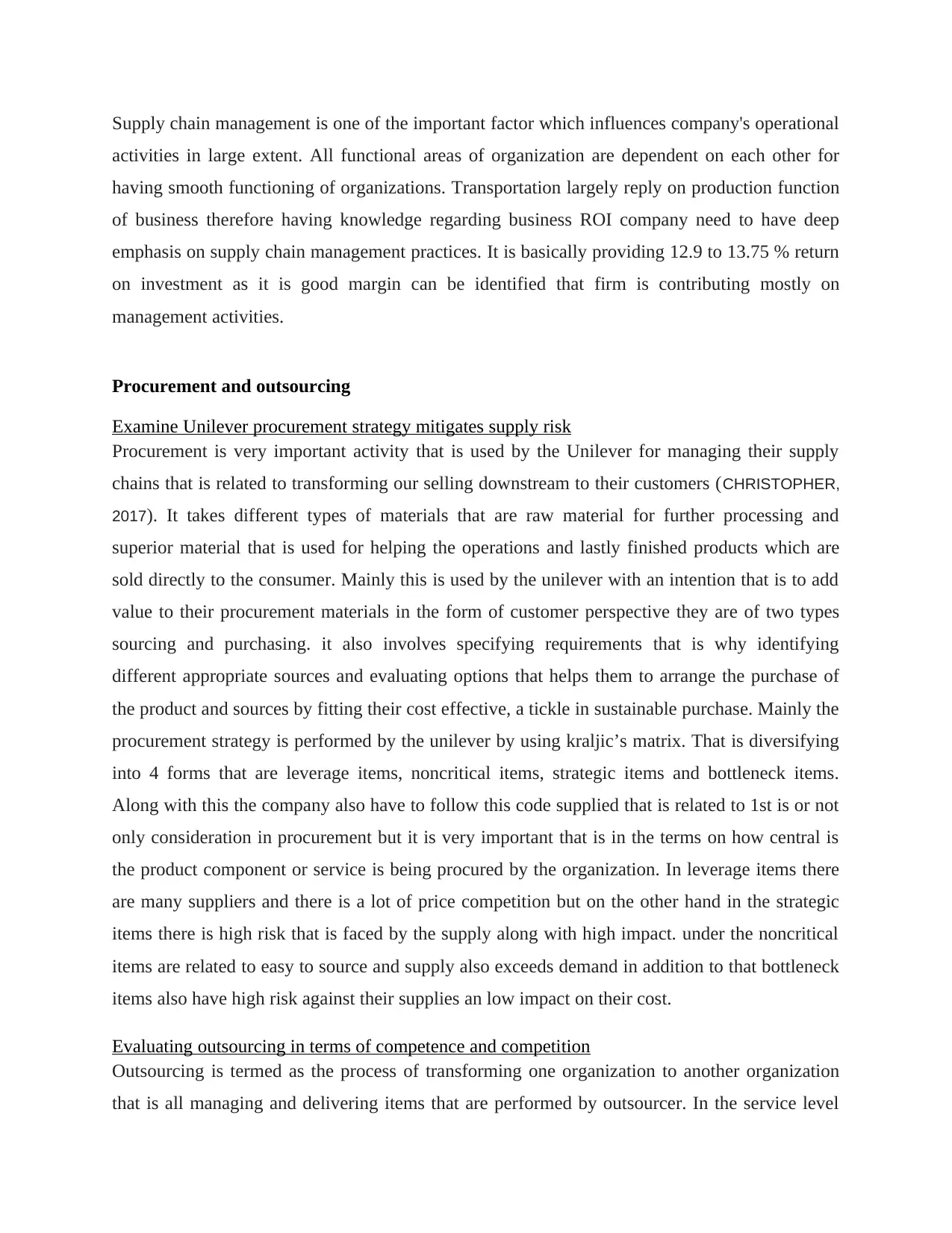
Supply chain management is one of the important factor which influences company's operational
activities in large extent. All functional areas of organization are dependent on each other for
having smooth functioning of organizations. Transportation largely reply on production function
of business therefore having knowledge regarding business ROI company need to have deep
emphasis on supply chain management practices. It is basically providing 12.9 to 13.75 % return
on investment as it is good margin can be identified that firm is contributing mostly on
management activities.
Procurement and outsourcing
Examine Unilever procurement strategy mitigates supply risk
Procurement is very important activity that is used by the Unilever for managing their supply
chains that is related to transforming our selling downstream to their customers (CHRISTOPHER,
2017). It takes different types of materials that are raw material for further processing and
superior material that is used for helping the operations and lastly finished products which are
sold directly to the consumer. Mainly this is used by the unilever with an intention that is to add
value to their procurement materials in the form of customer perspective they are of two types
sourcing and purchasing. it also involves specifying requirements that is why identifying
different appropriate sources and evaluating options that helps them to arrange the purchase of
the product and sources by fitting their cost effective, a tickle in sustainable purchase. Mainly the
procurement strategy is performed by the unilever by using kraljic’s matrix. That is diversifying
into 4 forms that are leverage items, noncritical items, strategic items and bottleneck items.
Along with this the company also have to follow this code supplied that is related to 1st is or not
only consideration in procurement but it is very important that is in the terms on how central is
the product component or service is being procured by the organization. In leverage items there
are many suppliers and there is a lot of price competition but on the other hand in the strategic
items there is high risk that is faced by the supply along with high impact. under the noncritical
items are related to easy to source and supply also exceeds demand in addition to that bottleneck
items also have high risk against their supplies an low impact on their cost.
Evaluating outsourcing in terms of competence and competition
Outsourcing is termed as the process of transforming one organization to another organization
that is all managing and delivering items that are performed by outsourcer. In the service level
activities in large extent. All functional areas of organization are dependent on each other for
having smooth functioning of organizations. Transportation largely reply on production function
of business therefore having knowledge regarding business ROI company need to have deep
emphasis on supply chain management practices. It is basically providing 12.9 to 13.75 % return
on investment as it is good margin can be identified that firm is contributing mostly on
management activities.
Procurement and outsourcing
Examine Unilever procurement strategy mitigates supply risk
Procurement is very important activity that is used by the Unilever for managing their supply
chains that is related to transforming our selling downstream to their customers (CHRISTOPHER,
2017). It takes different types of materials that are raw material for further processing and
superior material that is used for helping the operations and lastly finished products which are
sold directly to the consumer. Mainly this is used by the unilever with an intention that is to add
value to their procurement materials in the form of customer perspective they are of two types
sourcing and purchasing. it also involves specifying requirements that is why identifying
different appropriate sources and evaluating options that helps them to arrange the purchase of
the product and sources by fitting their cost effective, a tickle in sustainable purchase. Mainly the
procurement strategy is performed by the unilever by using kraljic’s matrix. That is diversifying
into 4 forms that are leverage items, noncritical items, strategic items and bottleneck items.
Along with this the company also have to follow this code supplied that is related to 1st is or not
only consideration in procurement but it is very important that is in the terms on how central is
the product component or service is being procured by the organization. In leverage items there
are many suppliers and there is a lot of price competition but on the other hand in the strategic
items there is high risk that is faced by the supply along with high impact. under the noncritical
items are related to easy to source and supply also exceeds demand in addition to that bottleneck
items also have high risk against their supplies an low impact on their cost.
Evaluating outsourcing in terms of competence and competition
Outsourcing is termed as the process of transforming one organization to another organization
that is all managing and delivering items that are performed by outsourcer. In the service level
⊘ This is a preview!⊘
Do you want full access?
Subscribe today to unlock all pages.

Trusted by 1+ million students worldwide
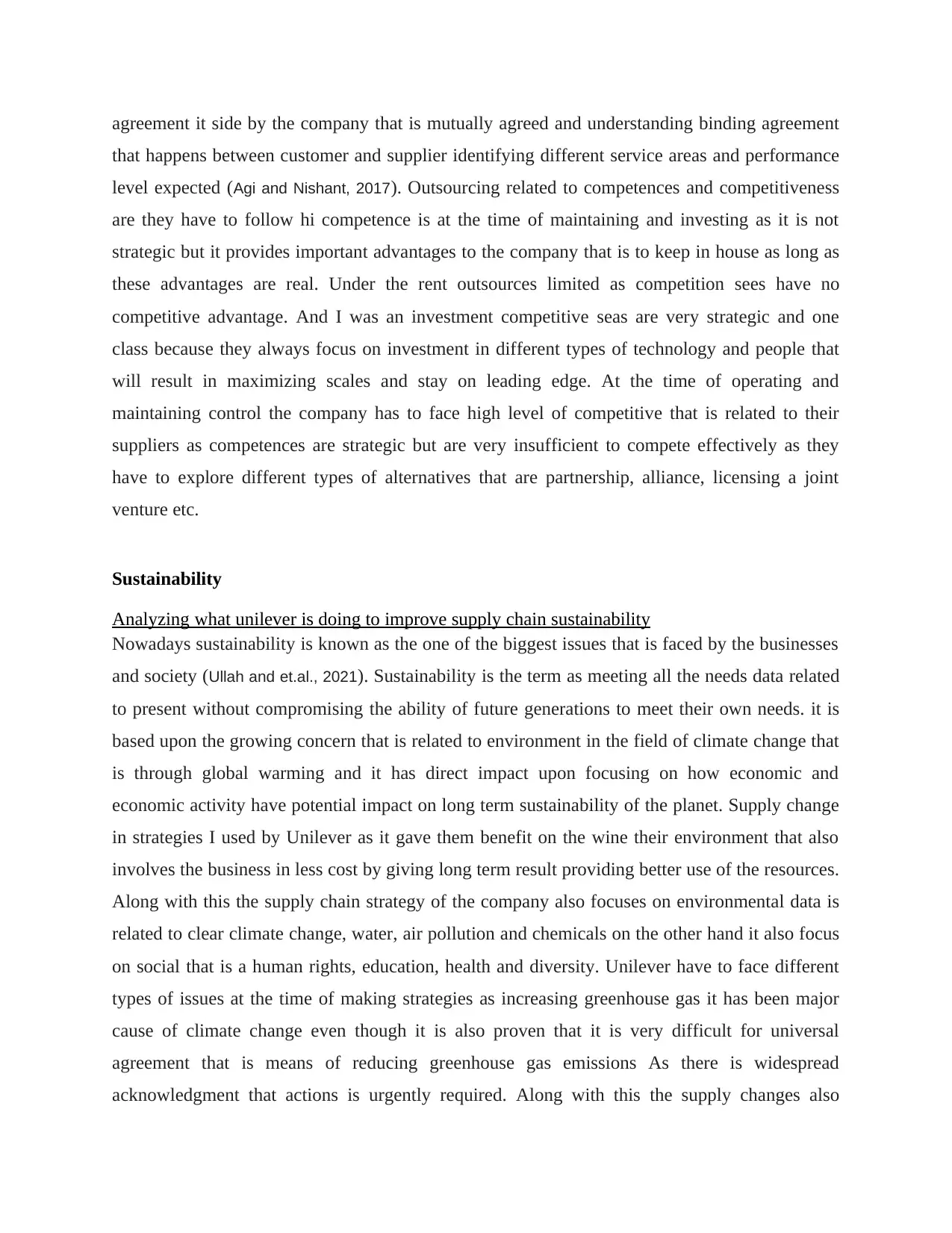
agreement it side by the company that is mutually agreed and understanding binding agreement
that happens between customer and supplier identifying different service areas and performance
level expected (Agi and Nishant, 2017). Outsourcing related to competences and competitiveness
are they have to follow hi competence is at the time of maintaining and investing as it is not
strategic but it provides important advantages to the company that is to keep in house as long as
these advantages are real. Under the rent outsources limited as competition sees have no
competitive advantage. And I was an investment competitive seas are very strategic and one
class because they always focus on investment in different types of technology and people that
will result in maximizing scales and stay on leading edge. At the time of operating and
maintaining control the company has to face high level of competitive that is related to their
suppliers as competences are strategic but are very insufficient to compete effectively as they
have to explore different types of alternatives that are partnership, alliance, licensing a joint
venture etc.
Sustainability
Analyzing what unilever is doing to improve supply chain sustainability
Nowadays sustainability is known as the one of the biggest issues that is faced by the businesses
and society (Ullah and et.al., 2021). Sustainability is the term as meeting all the needs data related
to present without compromising the ability of future generations to meet their own needs. it is
based upon the growing concern that is related to environment in the field of climate change that
is through global warming and it has direct impact upon focusing on how economic and
economic activity have potential impact on long term sustainability of the planet. Supply change
in strategies I used by Unilever as it gave them benefit on the wine their environment that also
involves the business in less cost by giving long term result providing better use of the resources.
Along with this the supply chain strategy of the company also focuses on environmental data is
related to clear climate change, water, air pollution and chemicals on the other hand it also focus
on social that is a human rights, education, health and diversity. Unilever have to face different
types of issues at the time of making strategies as increasing greenhouse gas it has been major
cause of climate change even though it is also proven that it is very difficult for universal
agreement that is means of reducing greenhouse gas emissions As there is widespread
acknowledgment that actions is urgently required. Along with this the supply changes also
that happens between customer and supplier identifying different service areas and performance
level expected (Agi and Nishant, 2017). Outsourcing related to competences and competitiveness
are they have to follow hi competence is at the time of maintaining and investing as it is not
strategic but it provides important advantages to the company that is to keep in house as long as
these advantages are real. Under the rent outsources limited as competition sees have no
competitive advantage. And I was an investment competitive seas are very strategic and one
class because they always focus on investment in different types of technology and people that
will result in maximizing scales and stay on leading edge. At the time of operating and
maintaining control the company has to face high level of competitive that is related to their
suppliers as competences are strategic but are very insufficient to compete effectively as they
have to explore different types of alternatives that are partnership, alliance, licensing a joint
venture etc.
Sustainability
Analyzing what unilever is doing to improve supply chain sustainability
Nowadays sustainability is known as the one of the biggest issues that is faced by the businesses
and society (Ullah and et.al., 2021). Sustainability is the term as meeting all the needs data related
to present without compromising the ability of future generations to meet their own needs. it is
based upon the growing concern that is related to environment in the field of climate change that
is through global warming and it has direct impact upon focusing on how economic and
economic activity have potential impact on long term sustainability of the planet. Supply change
in strategies I used by Unilever as it gave them benefit on the wine their environment that also
involves the business in less cost by giving long term result providing better use of the resources.
Along with this the supply chain strategy of the company also focuses on environmental data is
related to clear climate change, water, air pollution and chemicals on the other hand it also focus
on social that is a human rights, education, health and diversity. Unilever have to face different
types of issues at the time of making strategies as increasing greenhouse gas it has been major
cause of climate change even though it is also proven that it is very difficult for universal
agreement that is means of reducing greenhouse gas emissions As there is widespread
acknowledgment that actions is urgently required. Along with this the supply changes also
Paraphrase This Document
Need a fresh take? Get an instant paraphrase of this document with our AI Paraphraser
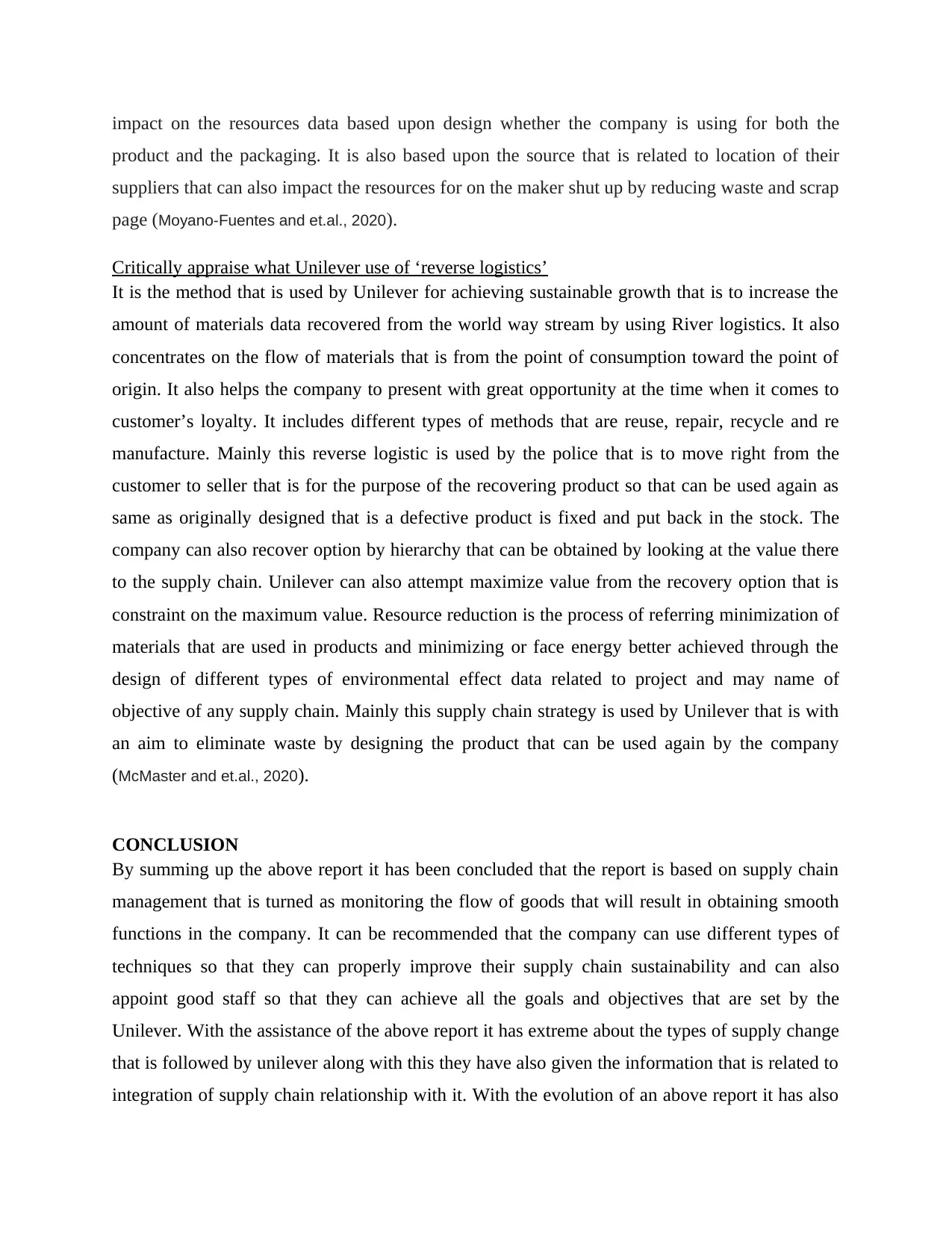
impact on the resources data based upon design whether the company is using for both the
product and the packaging. It is also based upon the source that is related to location of their
suppliers that can also impact the resources for on the maker shut up by reducing waste and scrap
page (Moyano-Fuentes and et.al., 2020).
Critically appraise what Unilever use of ‘reverse logistics’
It is the method that is used by Unilever for achieving sustainable growth that is to increase the
amount of materials data recovered from the world way stream by using River logistics. It also
concentrates on the flow of materials that is from the point of consumption toward the point of
origin. It also helps the company to present with great opportunity at the time when it comes to
customer’s loyalty. It includes different types of methods that are reuse, repair, recycle and re
manufacture. Mainly this reverse logistic is used by the police that is to move right from the
customer to seller that is for the purpose of the recovering product so that can be used again as
same as originally designed that is a defective product is fixed and put back in the stock. The
company can also recover option by hierarchy that can be obtained by looking at the value there
to the supply chain. Unilever can also attempt maximize value from the recovery option that is
constraint on the maximum value. Resource reduction is the process of referring minimization of
materials that are used in products and minimizing or face energy better achieved through the
design of different types of environmental effect data related to project and may name of
objective of any supply chain. Mainly this supply chain strategy is used by Unilever that is with
an aim to eliminate waste by designing the product that can be used again by the company
(McMaster and et.al., 2020).
CONCLUSION
By summing up the above report it has been concluded that the report is based on supply chain
management that is turned as monitoring the flow of goods that will result in obtaining smooth
functions in the company. It can be recommended that the company can use different types of
techniques so that they can properly improve their supply chain sustainability and can also
appoint good staff so that they can achieve all the goals and objectives that are set by the
Unilever. With the assistance of the above report it has extreme about the types of supply change
that is followed by unilever along with this they have also given the information that is related to
integration of supply chain relationship with it. With the evolution of an above report it has also
product and the packaging. It is also based upon the source that is related to location of their
suppliers that can also impact the resources for on the maker shut up by reducing waste and scrap
page (Moyano-Fuentes and et.al., 2020).
Critically appraise what Unilever use of ‘reverse logistics’
It is the method that is used by Unilever for achieving sustainable growth that is to increase the
amount of materials data recovered from the world way stream by using River logistics. It also
concentrates on the flow of materials that is from the point of consumption toward the point of
origin. It also helps the company to present with great opportunity at the time when it comes to
customer’s loyalty. It includes different types of methods that are reuse, repair, recycle and re
manufacture. Mainly this reverse logistic is used by the police that is to move right from the
customer to seller that is for the purpose of the recovering product so that can be used again as
same as originally designed that is a defective product is fixed and put back in the stock. The
company can also recover option by hierarchy that can be obtained by looking at the value there
to the supply chain. Unilever can also attempt maximize value from the recovery option that is
constraint on the maximum value. Resource reduction is the process of referring minimization of
materials that are used in products and minimizing or face energy better achieved through the
design of different types of environmental effect data related to project and may name of
objective of any supply chain. Mainly this supply chain strategy is used by Unilever that is with
an aim to eliminate waste by designing the product that can be used again by the company
(McMaster and et.al., 2020).
CONCLUSION
By summing up the above report it has been concluded that the report is based on supply chain
management that is turned as monitoring the flow of goods that will result in obtaining smooth
functions in the company. It can be recommended that the company can use different types of
techniques so that they can properly improve their supply chain sustainability and can also
appoint good staff so that they can achieve all the goals and objectives that are set by the
Unilever. With the assistance of the above report it has extreme about the types of supply change
that is followed by unilever along with this they have also given the information that is related to
integration of supply chain relationship with it. With the evolution of an above report it has also
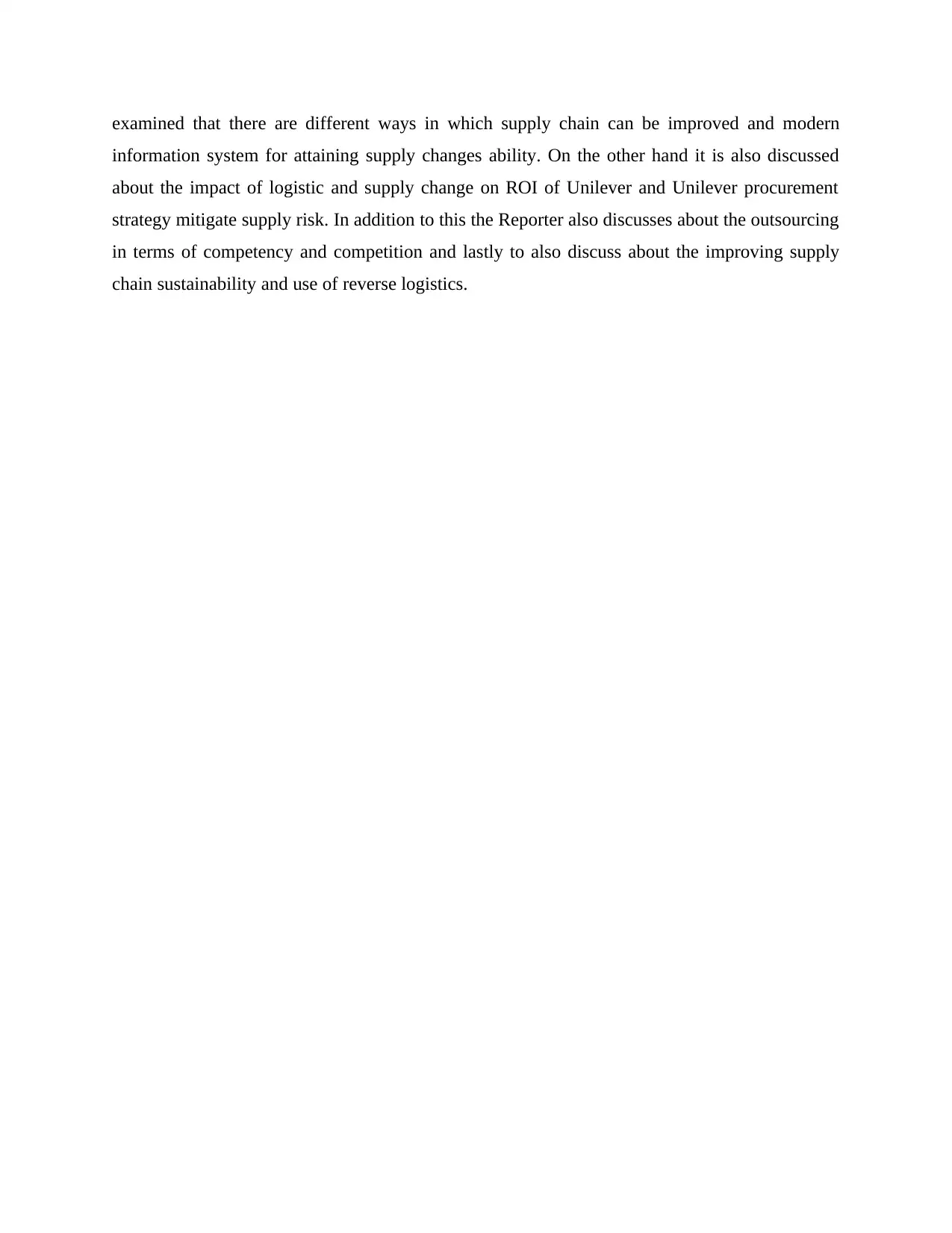
examined that there are different ways in which supply chain can be improved and modern
information system for attaining supply changes ability. On the other hand it is also discussed
about the impact of logistic and supply change on ROI of Unilever and Unilever procurement
strategy mitigate supply risk. In addition to this the Reporter also discusses about the outsourcing
in terms of competency and competition and lastly to also discuss about the improving supply
chain sustainability and use of reverse logistics.
information system for attaining supply changes ability. On the other hand it is also discussed
about the impact of logistic and supply change on ROI of Unilever and Unilever procurement
strategy mitigate supply risk. In addition to this the Reporter also discusses about the outsourcing
in terms of competency and competition and lastly to also discuss about the improving supply
chain sustainability and use of reverse logistics.
⊘ This is a preview!⊘
Do you want full access?
Subscribe today to unlock all pages.

Trusted by 1+ million students worldwide
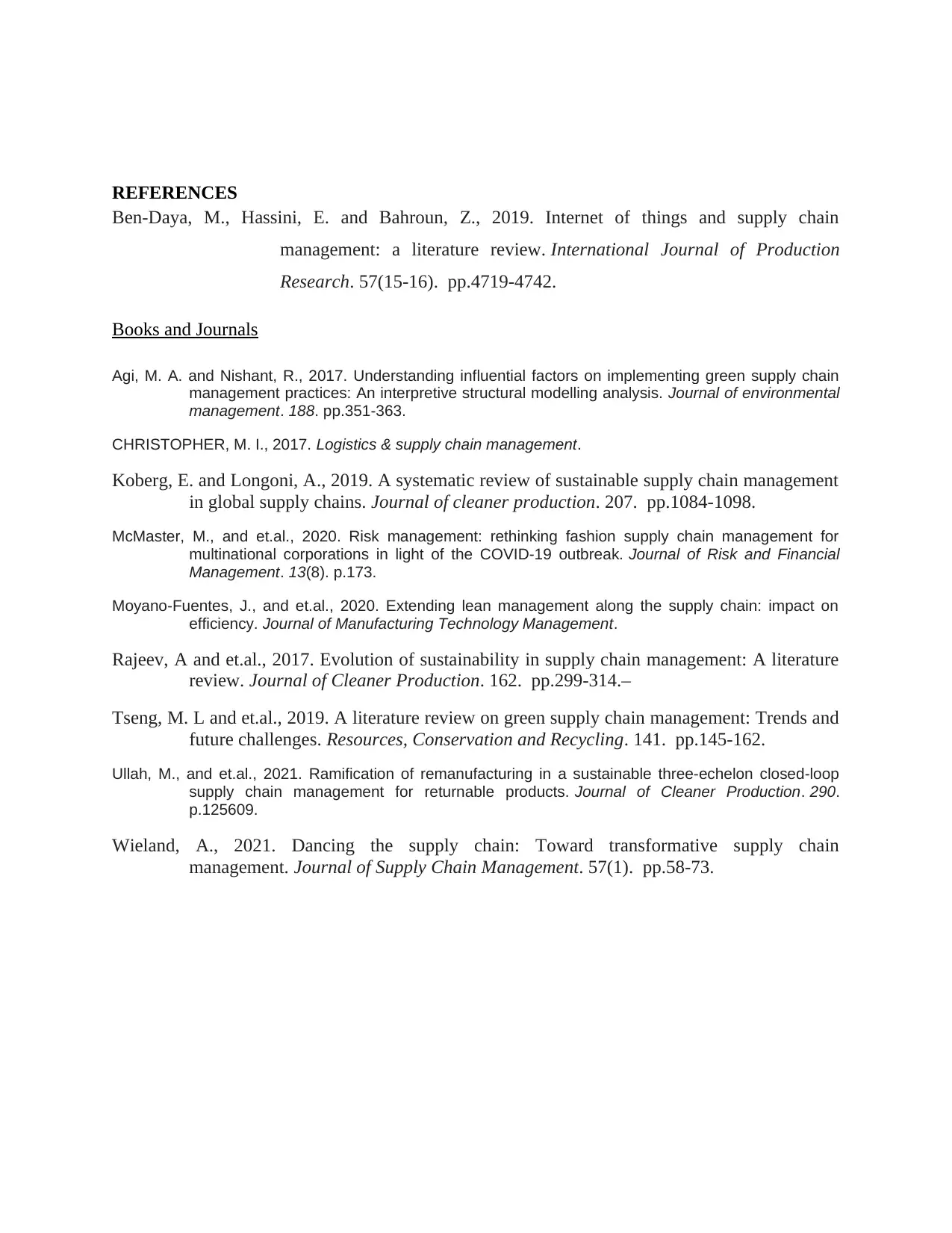
REFERENCES
Ben-Daya, M., Hassini, E. and Bahroun, Z., 2019. Internet of things and supply chain
management: a literature review. International Journal of Production
Research. 57(15-16). pp.4719-4742.
Books and Journals
Agi, M. A. and Nishant, R., 2017. Understanding influential factors on implementing green supply chain
management practices: An interpretive structural modelling analysis. Journal of environmental
management. 188. pp.351-363.
CHRISTOPHER, M. I., 2017. Logistics & supply chain management.
Koberg, E. and Longoni, A., 2019. A systematic review of sustainable supply chain management
in global supply chains. Journal of cleaner production. 207. pp.1084-1098.
McMaster, M., and et.al., 2020. Risk management: rethinking fashion supply chain management for
multinational corporations in light of the COVID-19 outbreak. Journal of Risk and Financial
Management. 13(8). p.173.
Moyano-Fuentes, J., and et.al., 2020. Extending lean management along the supply chain: impact on
efficiency. Journal of Manufacturing Technology Management.
Rajeev, A and et.al., 2017. Evolution of sustainability in supply chain management: A literature
review. Journal of Cleaner Production. 162. pp.299-314.–
Tseng, M. L and et.al., 2019. A literature review on green supply chain management: Trends and
future challenges. Resources, Conservation and Recycling. 141. pp.145-162.
Ullah, M., and et.al., 2021. Ramification of remanufacturing in a sustainable three-echelon closed-loop
supply chain management for returnable products. Journal of Cleaner Production. 290.
p.125609.
Wieland, A., 2021. Dancing the supply chain: Toward transformative supply chain
management. Journal of Supply Chain Management. 57(1). pp.58-73.
Ben-Daya, M., Hassini, E. and Bahroun, Z., 2019. Internet of things and supply chain
management: a literature review. International Journal of Production
Research. 57(15-16). pp.4719-4742.
Books and Journals
Agi, M. A. and Nishant, R., 2017. Understanding influential factors on implementing green supply chain
management practices: An interpretive structural modelling analysis. Journal of environmental
management. 188. pp.351-363.
CHRISTOPHER, M. I., 2017. Logistics & supply chain management.
Koberg, E. and Longoni, A., 2019. A systematic review of sustainable supply chain management
in global supply chains. Journal of cleaner production. 207. pp.1084-1098.
McMaster, M., and et.al., 2020. Risk management: rethinking fashion supply chain management for
multinational corporations in light of the COVID-19 outbreak. Journal of Risk and Financial
Management. 13(8). p.173.
Moyano-Fuentes, J., and et.al., 2020. Extending lean management along the supply chain: impact on
efficiency. Journal of Manufacturing Technology Management.
Rajeev, A and et.al., 2017. Evolution of sustainability in supply chain management: A literature
review. Journal of Cleaner Production. 162. pp.299-314.–
Tseng, M. L and et.al., 2019. A literature review on green supply chain management: Trends and
future challenges. Resources, Conservation and Recycling. 141. pp.145-162.
Ullah, M., and et.al., 2021. Ramification of remanufacturing in a sustainable three-echelon closed-loop
supply chain management for returnable products. Journal of Cleaner Production. 290.
p.125609.
Wieland, A., 2021. Dancing the supply chain: Toward transformative supply chain
management. Journal of Supply Chain Management. 57(1). pp.58-73.
1 out of 10
Related Documents
Your All-in-One AI-Powered Toolkit for Academic Success.
+13062052269
info@desklib.com
Available 24*7 on WhatsApp / Email
![[object Object]](/_next/static/media/star-bottom.7253800d.svg)
Unlock your academic potential
Copyright © 2020–2025 A2Z Services. All Rights Reserved. Developed and managed by ZUCOL.





